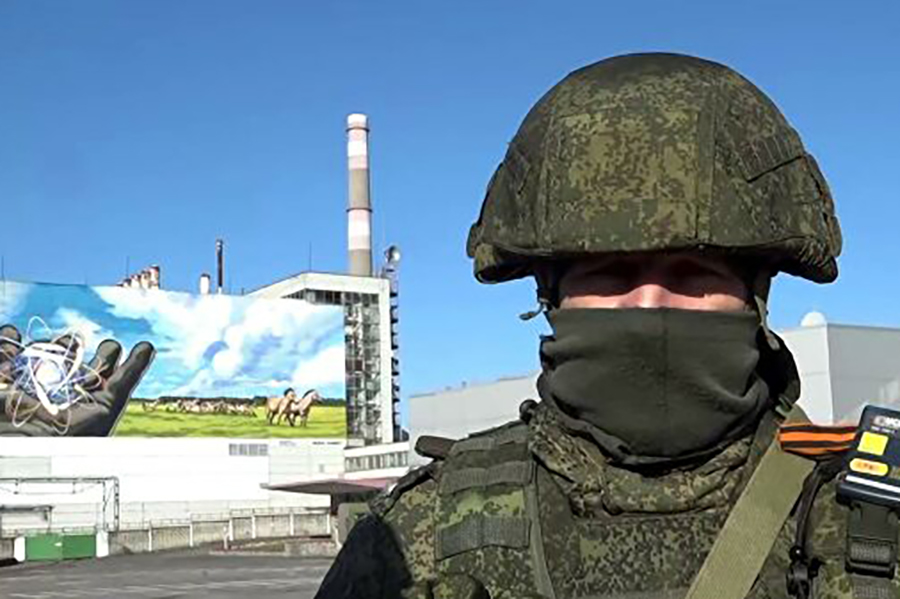
The Russian Federation has proved that it is not planning to abide by the rules of war established by international law. In addition to bombing residential areas and civilian infrastructure Russian troops have encroached upon international security and resorted to nuclear terrorism.
O n February 24, forces of the invaders took control of Chornobyl nuclear power plant which includes three non-operating units, a sarcophagus over the destroyed unit, and a spent nuclear fuel storage facility. Station staff are held hostage, people are exhausted as rotation is not allowed. On March 9, the IAEA (International Atomic Energy Agency) announced that it had no connection with its monitoring equipment which would signal all Chornobyl nuclear materials were in place.
On March 9th (and for the second time on the 14th), as a result of the invaders’ actions Chornobyl nuclear power plant was completely de-energized. At the same time invaders did not allow National Energy Company “Ukrenergo” employees to repair high-voltage lines. According to “Energoatom” company , the consequences could have been a catastrophe as cooling systems wouldn’t work without electricity. Spent nuclear fuel could begin to heat up and emit radioactive substances. The cloud of these substances could enter the territories of neighbouring countries. If the facility caught on fire due to hostilities, the fire extinguishing system would not work without electricity, which would also be a disaster. On March 13th and 15th, due to the efforts of Ukrainian repairmen, energy supply to Chornobyl nuclear power plant was restored.
On the night of March 4th, forces of the invaders with about 100 units of heavy equipment broke through Enerhodar and shelled the Zaporizhia NPP, its office buildings and infrastructure, smashing the training building, hitting the power unit and damaging the Heat Supply overpass to Enerhodar. For a long time, Russian troops did not allow firefighters to put out the fire in the office building.

Zaporizhia NPP is the largest power plant in Europe. Its total installed capacity is 6,000 MW. Although ZNPP operates according to modern safety standards there are risks of radiation and environmental disaster, in case of hostilities. As of March 15th, the enemy continues to control the station and the operating company cannot check the nuclear and radiation situation at the station.
The whole world remembers the scale of the Chornobyl accident in 1986. Then the effect of radiation spread to 200 thousand square kilometers, significant pollution spread to the territory of Belarus and Russian Federation. The countries of Central Europe, the Scandinavian and Balkan peninsulas were also affected. In 1986 Chornobyl one power unit was damaged, while at the Zaporizhia NPP there are six such units. The consequences of unprofessional handling of reactor units are difficult to predict. At the same time, ZNPP staff are being held hostage, tortured, and physically and psychologically exhausted. On March 14th, “Energoatom” company reported that the Russian military had detonated some of the ammunition on the site of the occupied Zaporizhia nuclear power plant. Another risky aspect is spent nuclear fuel.
150 containers are stored on the plant territory. If a projectile hits the storage facility, it could lead to a radioactive release and an environmental disaster.
The Office of the Prosecutor General of Ukraine has launched proceedings under the article “ecocide” on Russia’s actions at the Chornobyl and Zaporizhia NPPs.
Ecocide
Mass destruction of flora and fauna, poisoning of the atmosphere or water resources as well as other actions that could cause an environmental disaster. Violation of human habitat as a result of hostilities is an especially severe form of ecocide.On March 6 and 10, Russian invaders shelled Kharkiv Physics and Technology Institute with MLRS “Hrad”. The Insititute houses a nuclear facility loaded with 37 nuclear fuel cells. Damage to installations or nuclear materials can also lead to radioactive release.

On March 11, the Main Intelligence Directorate of the Ministry of Defense of Ukraine announced that the President of the Russian Federation had given an order to prepare a terrorist attack at the Chornobyl nuclear power plant. Russian troops controlling the nuclear power plant plan to create a man-made disaster, transferring the responsibility for it to Ukraine.

Such events demonstrate that Russia does not shy away from any means of achieving their goals. Russia literally uses nuclear power plant as a weapon creating a threat of a nuclear disaster to blackmail the world. The occupiers turn nuclear power plants into military facilities by shelling them and placing heavy equipment on its territories. According to state terminology developed with the help of OSCE, such actions can be classified as acts of nuclear terrorism.

On March 3, the IAEA adopted a resolution condemning Russia’s actions in Ukraine, particularly the occupation of Chornobyl NPP by Russian troops. However, in order to stop nuclear terrorism, the international community must act more decisively as it is a direct threat to the environmental security of the region and the whole world. One of the IAEA’s key aims is to keep nuclear power from being used as a weapon. It is the first time in its history that one member state has attacked the nuclear facilities of another member state. The international organization and the countries of the “nuclear club” must immediately promote the introduction of a regime of a closed sky over Ukraine, particularly to protect critical infrastructure.

